Text
Create the myth of a world
The One-Page RPG Jam just wrapped up. I’ve joined every year since I started making games, and although I almost missed the deadline this time, inspiration struck at the last moment, and I just had to run with it.
The optional theme this year was growth, and after a week of half-formed ideas, something clicked: what if there was a tool that let us imagine the history of a world before the "first age" of adventurers? A cosmology generator, a mythmaker.

With just a standard deck of cards, 1–6 players, and a single page of rules, you take on the role of primordial gods shaping a new world. From its very inception, through ages of Elder Beings, Avatars, Wonders, cataclysms, and finally the arrival of Mortal Kins with their wars and migrations, you will weave myths of divine drama and strife, all the while drawing the map of the world itself.
Here’s a snapshot from one of my recent playtests:

I think it turned out pretty cool!
Fun fact: I actually recreated this game from scratch three times. The first draft was a complete headless mess. The second version morphed into a board game which, while fun, felt too mechanical and perfunctory. Finally, I landed where I wanted to be—a tool for crafting the origin myths of a world.
You can get the game here.
6 notes
·
View notes
Text
More than Ok, a PUSH-inspired pinball TTRPG is awesome!
Silverball Strike, the pinball TTRPG!
Addendum, and also Nudging
You know, I was so excited yesterday to just get something out, that I actually completely forgot something I told myself I wanted to do when writing these posts: Not just explain the rules and mechanics, but also the reasoning behind those mechanics. So let's get that out of the way for the "Making A Shot" mechanic first.
Pinball is very much about controlling the chaos. The ball is darting around the table, colliding with all sorts of obstacles, a lot of which are explicitly designed to have the ball ricochet right back at high speed. Lots of people starting out with pinball will just wildly press the flipper buttons to keep the ball from draining, but more experienced pinball players will make aimed shots and use techniques to get the ball under control. This is what I wanted to emulate with the Control mechanic and the cards. Drawing cards from a deck is inherently random, but of course, the more cards you draw at once, the higher your chance of getting the one you want. So having a higher Control value means drawing more cards, which emulates having more control over the ball. But the more cards you take at once, the more shots you're trying to make in quick succession, meaning you're losing control over the ball more quickly.
So, that's how you lose control. But how do you gain it. Well, that's where Nudging comes into play.
In pinball, nudging the machine to influence the way the ball will roll is a key technique that every player has to learn to use to be competitive (I admit, I myself struggle with it still). But if you could just shuffle the machine around willy-nilly, the game would lose most of its skill aspect. That's why pinball machines have mechanisms in place to keep players from overdoing it with the nudging: Do it to much or too heavily, and you get a warning. Get three warnings, and you'll "Tilt", which means the game will turn off your flippers, guaranteeing that your ball will drain. And you won't even get the end of ball bonus you usually get when your ball normally drains.
So, how does that work in Silverball Strike? Well, before I explain that, let me quickly say that, while I initially had my own idea for it, I eventually had a "Eureka" moment where I realized that the ideal way to do this would be to just steal someone else's idea.
Push by @capacle is a neat little rules-lite system which is - as the title might suggest - all about pushing your luck. Which, of course, is what nudging is all about. So, let me just quickly borrow and modify Push's core mechanic (hope it's okay Cezar!) for the Nudging mechanic:
As said in my last post everyone has a Low Tilt Tolerance (LTT) of 5 and a High Tilt Tolerance (HTT) of 6. I'm still thinking about how those could be modified during a campaign, or maybe even character creation.
If you decide to use the Nudge action on your turn, you roll 1d6. If the result is at least equal to your LTT, while not exceeding your HTT (or in other words, going with the starting values stated above, if it's a 5 or a 6), you gain 2 points of Control! If your result is lower than your LTT, you get a choice: You can either gain 1 Control AND 1 Warning, or you can roll again. If you roll again, you have to add your new result to your old result. If the total is still lower than your LTT, you get to make the same choice again, and if you decide to roll again, you add the new result to the sum of the previous results, and so on. So if, on your first roll, you roll a 1 and roll again, and then on your second you roll a 2, you now have a total of 3. If you now decide to roll again, you have to add the new result to that 3.
But beware! If your total ever exceeds your HTT (so, assuming base stats, it becomes 7 or higher), you will JUST get a Warning, while gaining no Control, and your turn ends.
So, what's up with these Warnings? Well, they don't do anything for the first two... but once you get your third one, you immediately lose a ball, as well as all face cards lying in front of you. But also, of course, your Warnings will be reset to 0.
And... that's Nudging. Feel free to ask questions, btw. I'm gonna open the Ask Box as soon as I publish this post.
6 notes
·
View notes
Text
Weird, Whimsy & Wonder
I gotta be honest, I’m getting real tired of my own ideas.
I’m running a long-running Everspark campaign for my home group (over 30 sessions now!), and while it’s been amazing, I’m starting to notice a pattern: I keep recycling the same kinds of stuff. Floating objects. Glowing things. Cults. Always a cult. And the thing is, even though I’m using random tables and oracles, it still ends up looping through the same creative ruts.
I think that no matter if we prep ahead or improvise at the table, we rely on the same methods: pulling from existing content, using random tables, making stuff up, or free-associating from vague prompts.
But all of them have limits: either the material runs dry or you do. Even spark tables, which I love and use often (shoutout to Random Realities), can’t fully save you from your own mental habits. So I’ve been wondering: is there a tool that can actually dislodge you from your creative defaults, and help you make something that feels truly new?
You knew this was coming, but yeah, I made a tool for that.
Behold, Weird, Whimsy & Wonder (I also drew this cover art with a combination of photobashing public domain art and my own sketches, which was fun. Please appreciate the fishdude. I love the fishdude).

I could’ve come up with a large set of random tables with predefined out-of-the-box entries full of strange ideas, but that would have only got you so far (and also, Monte Cook Games already published ‘The Weird’, which does just that, brilliantly). Soon enough, those once unique entries would start to feel like the tired ones, or just be completely out of place for your context.
Instead, I opt to create a tight procedure—also aided by random tables, mind you—that allows you to start with a spark of an idea and elevate it to make it eerie, delightful or majestic. You push, pull, stretch, combine, morph and voilà, something your players will never forget.
You can craft encounters, NPCs, locations, monsters, items and more, using the same procedure. It’s great for GM prep or improv, and also fantastic for solo players.
You can see it in action here (or read a full example here):
youtube
I’m taking it to BackerKit, and I’m partnering with Critical Kit to offer the physical version as well.��This is my first time on BK, and with physical tiers, and I am terrified. Can't do this without your help.
The pre-launch page is already up so you can follow today—and if you back it in the first 48 hours, you get a free postcard with a unique random table on the back—The Weird-o-Mator, instant formulas to weirdify anything.

Also, there's a FREE ONLINE DEMO you can try out today. Just follow the link.
11 notes
·
View notes
Text
Everspark is finalist as Best Indie TTRPG of the Year!!
I'm thrilled to announce that Everspark is a finalist as Best Indie TTRPG of the Year at the Crit Awards, among other incredible games!
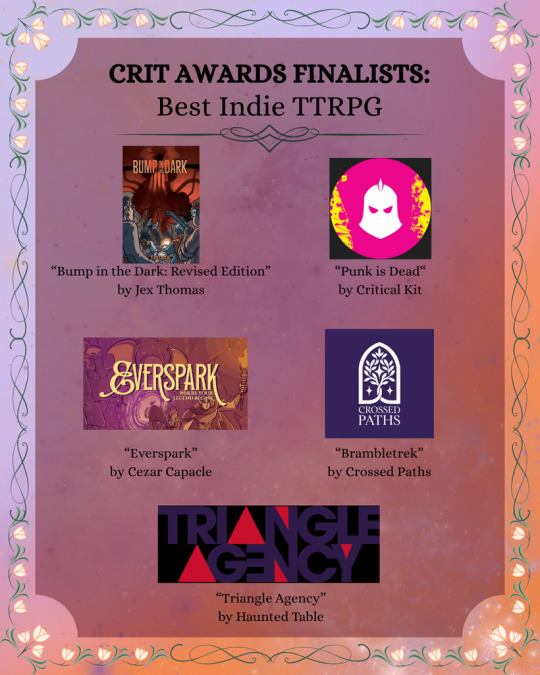
Isn't that fantastic? If you want to cast a vote for Everspark (or any other of your preference, really), here's how:
There are 50 categories to vote for (you don't need to vote for all of them, but they are all there for your consideration)
The voting form is here: https://docs.google.com/forms/d/e/1FAIpQLSf8YSKrjEei20hfNnH1TgJ3MgeNoTcjEcEuT_zaOVWHASuCXQ/viewform
If you want to read the list with all the finalists first, follow this link: https://docs.google.com/document/d/1REC7Pu8P6saFltG8sA-e7tdAz9_2BQFlM1LhTfHkyKs/edit
Thank you so much for your support and enthusiasm!
22 notes
·
View notes
Text
Solarpunk, realism, dystopia: a rant






Hopefully this is helpful to someone out there 🌸
You can find the Prompts podcast here, I drew some of the covers :D Also check out this digital library full of Creative Commons Solarpunk art (neither of these are sponsored).
🦗Somewhat shameful plug🦗
I would highly appreciate if you threw me a couple bucks on Buy Me a Coffee or bought a commission, my money number is only getting smaller these days 😔🤙
10K notes
·
View notes
Text
stationery shops should be called paperies and I’ll never not be disappointed that this is not the case.
11 notes
·
View notes
Text
The intense minutes before a stealthy mission
So yeah, I am funding a new game.

Before the Storm is a solo journaling RPG about the electric stillness before a high-stakes operation—a heist, an assassination, a stealth infiltration. You are already in position: perched in the shadows, breath held, waiting for the moment to strike. The job is minutes away, but your mind is racing, your senses heightened. This is the calm before everything changes.
Using a standard deck of playing cards, you’ll draw prompts that describe what you feel, hear, see and think. Perched in the shadows, you reflect, observe, and brace for impact—while building a puzzle-like poker hand that reveals your state of mind in the final breath before action.

You can play it standalone as a complete solo experience, with prompts that help you envision your character, their mission, and a setting that can range from medieval to cyberpunk. Or slot it into an ongoing campaign to zoom in on a moment of quiet tension before a mission.
Each card gives you a moment: something you sense, remember, question, or notice in the shadows while waiting for the right moment to act. A leading question guides your reflection: about your state of mind, your past, your doubts, or your instincts.
But that’s just half of it.

Alongside the narrative, you’ll be playing a custom variation of poker solitaire. As you draw each card, you place it onto the table, building a grid. Your goal is to form the strongest possible poker hand in a straight line—horizontal, vertical, or diagonal.

Each new card must be placed adjacent to the last. Your entire layout must fit within an imaginary 5x5 grid. If you place a card outside that space, the grid shifts—and you’ll lose any cards left behind. The rules are quite simple (less than three pages), but the strategic tension builds fast (I have to say, this card mechanic works surprisingly well as its own solo puzzle game).

When you finally complete a line of five cards, the game ends. That line becomes your poker hand, and its strength determines your emotional and mental state in the final moment before action.
From there, you can leave the scene as a cliffhanger. Or jump into your system of choice to play out the mission itself. If you’re using Before the Storm as a plug-and-play, your final hand can offer narrative momentum—or even mechanical advantages and complications, depending on the system you’re using.

So if this feels like your jam, check out the campaign and help me spread the word!
73 notes
·
View notes
Text
Roll first, think later
There’s a fascinating phenomenon I observe every time I play with beginners.
Of all the unwritten rules new players are expected to grasp through play, a very common one is when to interject their narrative with a dice roll. Sure, most games have a variation of “describe what you want to do, and then roll the dice to see how it goes,” but exactly when one should stop narrating what happens and let the dice tell part of the story is more of an art form.
I usually see beginners falling somewhere between one of two ends of the spectrum. There’s either:
Player: “I swing my sword at them and cut them in half, and I look around, and the princess has fallen in love with me.” GM: “Wait, wait, wait. Let’s, uh… start with the attack roll first. How about that?”
Or:
GM: “It’s your turn.” Player: “Oh.” *rolls a d20* GM: “Wait, wait, wait. What are you even trying to do?”
It usually takes a few rolls (or a few sessions), but once we grasp that timing, it becomes so second nature that any game that subverts that norm feels… weird.
Well, it just so happens that I love weird.

“I punch them and knock them out.” Photo by Johann Walter Bantz on Unsplash
The misfortunes of fortune
When I say “norm” above, I’m oversimplifying. Different games have different moments when you’re expected to stop and roll the dice. Even within the same game, different types of action might call for different timing in rolls.
This "dice roll placement" is what is normally referred to as fortune positioning, and if you search online for “fortune in the middle”, for example, you’ll find… well, contradicting definitions. But that’s beside the point. What’s important is that fortune positioning determines at which point in the trajectory from declaration of intent and narrated outcome we stop to check the dice (or any form of resolution mechanic, really).
Traditionally, players learn when and how to do it by experience—observing their friends, absorbing table culture, and getting it wrong a few times until they get a feel for it.
For some actions, it is easier to tell the right moment. If you are using a specific ability, there’s usually a well-defined order in which things happen. You say, “I’m going to activate my Soul Blast” or whatever, and we go, “OK, roll, and then we see what happens.”
Things get murkier when there’s no hard-coded procedures, like social situations in trad games. You perform that incredible speech but roll poorly—now what? Do we undo what you just said? Do we make some mental gymnastics to justify why it didn’t land? Should you have gotten a bonus because of your roleplay? But if your character is not very charismatic in the first place, should they have even been able to articulate such a compelling argument? Endless discussions over this topic alone have filled forums for the past decades.
Even when games have a much clearer instruction about fortune positioning—like PbtA games, which literally have a trigger for every move—it is still an acquired skill to understand when to shut your mouth and say, “Well, I guess we have to roll now, right?”.

“Well, I guess I actually insulted the king instead.” Photo by Julia Taubitz on Unsplash
Fortune at the extremes
There’s no one solution for that situation, because, at least for me, it is not a problem to begin with. I see it instead as a fertile ground for experimentation.
I’ve tried different approaches for fortune positioning with my games, and I especially like to push the needle beyond what’s usually considered the far ends of the spectrum. Let me explain what I mean.
See, when people describe “fortune at the end”, it usually implies that you describe everything that your character is able to do to affect the outcome, then you roll the dice, and then narrate the result. But what if you narrated even the outcome before you rolled the dice?
That’s what I did in Insurgent. The game says:
Regardless of your result, everything you describe happens exactly how you describe it. The roll of the dice determines the fallout of your action.
See, the dice don’t determine whether you succeed in your intended action. Instead, you describe the whole action beforehand, including its result. The dice inform the consequences of your action. A “fortune at the very end” kind of roll, perhaps?
At the other end of the spectrum, we have “fortune at the beginning,” which is usually described as rolling right after a declaration of intent and approach, using the dice result to inform what and how it happens. But��� can’t we go even further back? What if we rolled before we decided what to do?
Fortune at point zero
That example at the beginning—the player enthusiastically reaching for the dice and rolling even before clarifying their intention—always stuck with me. What if we didn’t try to stop it, but instead leaned into it as the intended behavior?
For that to work, I figured that the system would have to follow these criteria:
All rolls in the game should be the same.
A roll is expected to be made at every turn.
There should be meaningful choices after the roll is made.
I finally managed to pull it off in my latest release, Load the Simulation. Let me show you how I followed these criteria and why I believe it works.
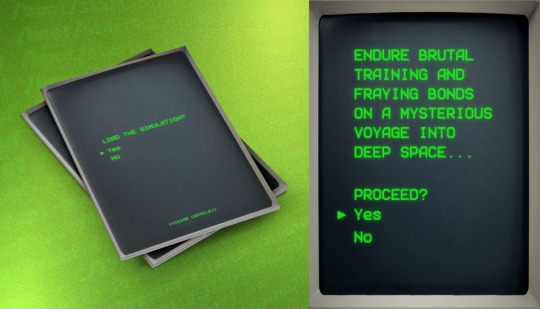
At the top of your turn, before you even think about your action, you grab 3d6 and roll them. It’s always 3d6, and there are no modifiers. If you had attributes, skills or actions that indicated different modifiers (like d20 systems), dice pools (as in Blades in the Dark), dice sizes (as in Savage Worlds), or dice pools and sizes (like in Cortex Prime), that wouldn’t work. You’d at least need to declare your approach before rolling. I didn’t want that, so all rolls are the same (meeting the first criterion).
These rolls happen during the training exercise—your character is on a centuries-long mission to prepare exoplanets for colonization, and you’re going through training simulations (think The Matrix, X-Men or Star Trek). Since every turn represents an attempt to progress toward your mission objective, a roll is always required (meeting the second criterion). In a more open-ended scenario, that assumption wouldn’t necessarily apply.
Each die represents something different:
• The YOU die – Your character’s effort.
• The FOE die – The opposition.
• The ECO die – The environment.
You roll them together and arrange the results in a vertical line on the table, from highest to lowest— the Stack. The die with the highest roll determines the dominant force in the scene. If the YOU die is not the highest, you’ll take Conditions. You have to choose whether to affect:
Your body (Harm) – Bruises, burns, or worse.
Your mind (Stress) – The slow wear of fear and pressure.
Your relationships (Friction) – Putting crewmates in danger, failing to have their back, or blaming them for your mistakes.
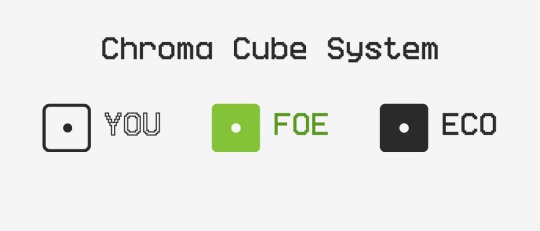
You can also choose to break one of your modules to avoid a condition, or use them in the scene to break a tie. So there’s this short mini-game you play after you roll to determine the mechanical implications of your roll (the third criterion).
With all the mechanical bits resolved, you’re left with a scene to paint. The roll generated a lot of input, and you can create a rich narrative that won’t later be contradicted by a dice roll.
Say the ECO die is higher, and you marked Friction. How does the environment take central stage, and how does that affect your bonds with your crewmates? Perhaps a tremor opens a giant crack in the ground, you grab your friend by the arm to keep balance, but end up sending them tumbling down near the edge of the cliff. That is… so much fun!
You get to look at the dice as a fortune-teller reading runes, and extract juicy, colorful fiction from the results. You decide if you’re in a more active position, taking the lead and making progress, or in a more reactive one, trying to resist this alien world that is trying to crush you.

See, it is not that you are abdicating control over what your character does by rolling before deciding. You still have total freedom of choice, but you’re informed of the outcome beforehand, so you get to frame that snippet of a scene, including actions and reactions, in a vivid way that incorporates everything you accomplished and everything you suffered in the process. And I think that’s neat.
There’s more nuance to it (each combination of dice position has different mechanical ramifications), but that’s the gist of it. I’m certainly not the first person to think of the roll first, think later approach to resolution mechanics, but I am really excited about how I managed to implement it in Load the Simulation.
If you want to learn more about this game of high-octane training simulations and intense interpersonal conflict, the crowdfunding campaing started yesterday and I'd love your support.
48 notes
·
View notes
Text
Train hard. Hold together. Drift alone.
My Zine Month 2025 campaign is live!

Load the Simulation is a tabletop role-playing game set aboard a massive spaceship on a centuries-long mission to discover and prepare exoplanets for colonization. Players take on the roles of crew members selected not for their prestige but as the essential yet overlooked backbone of the mission—explorers, frontierspeople, and problem solvers who are also expected to clean up any messes (literal or figurative) they encounter along the way.

Waking from cryogenic sleep, these characters find themselves thrust into rigorous and unpredictable training simulations orchestrated by the ship’s AI, DAX. Each day, they are dropped into a different simulated environment—wildly alien, utterly unpredictable, and filled with potential threats—to prepare them for the unknown dangers that await when the ship finally reaches its destination. Think of the high-octane training sequences from The Matrix, the Danger Room in X-Men, or the holodecks in Star Trek.
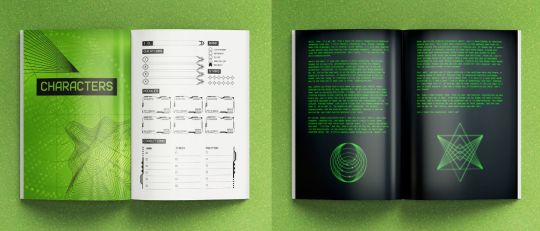
Outside the simulations, players navigate the interpersonal challenges and emotional tensions of life aboard a confined spaceship. Bonds are formed and frayed as crewmates work together to overcome challenges, while personal goals and differences create moments of connection and conflict. Between these dynamics, players spend time recovering in the medical bay, repairing and upgrading their gear, and working on personal projects to keep their minds sharp. All the while, they grapple with the emotional strain of an extreme voyage into the unknown, unraveling hints of a deeper mystery about the mission’s true purpose.

The campaign just launched with a limited Early Bird discount, so check it out! There's some more explanation of the system on the page as well!
#indie ttrpg#zinequest#zine month#ttrpg#solorpg#crowdfunding#global south#ttrpg design#ttrpgsolidarity#ttrpg community
22 notes
·
View notes
Text
Everspark is available!
Good news, peeps!
If you missed the Everspark campaign, now it is available as a pre-launch sale on itch! And you get immediate access to the updated beta version (nearly the final game) for a discounted price!
Share the news! 🌟

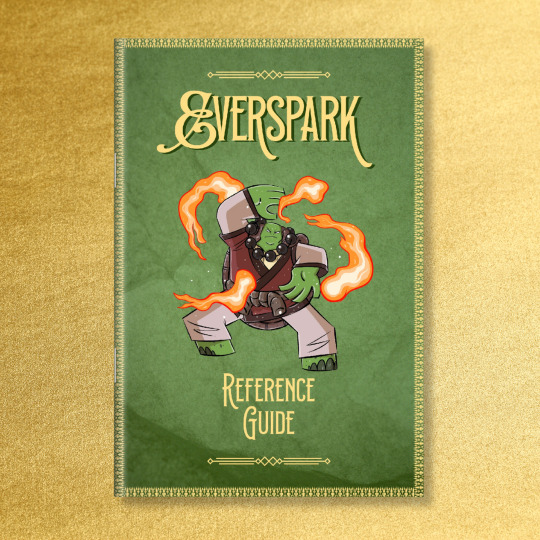
https://capacle.itch.io/everspark
12 notes
·
View notes
Text
Drawing stars on sticky notes?
What do you get when you combine Progress Clocks, Aspects, Usage Dice, and Insight Rolls?
If you answered “an unholy mess”, well, that’d have been my guess too if someone asked me that. But that didn’t stop me from doing it anyway. And, surprisingly, instead of creating an abomination that shouldn’t see the light of the day, it became the core mechanic of my newest game, one that I’m giddily excited about.
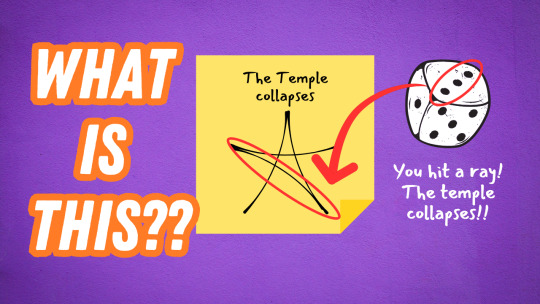
I want to dive deeper into this quirky little mechanic called Sparks, that involves drawing stars on sticky notes. In essence, it is a tool to track progress of any kind. Towards a goal, an event, an effect, whatever. But in a closer look… well, it is more than that.
Escaping the temple
Let’s say you grab an ancient idol from a cursed temple, triggering a self-destruction spell. You need to escape before the temple collapses and traps you inside. You’d grab a sticky note, write “The Temple Collapses,” and place it on the table. Your Spark is now created.

To advance the Spark, you’d add rays to the star when certain fictional or mechanical triggers occur. For example, if you spend too much time in a room while trying to escape, you might add a ray to represent the passage of time. Or say you try to place a heavy rock in place of the idol to stop the spell, and you roll a bad Fate Check (the equivalent of a Yes/No Oracle or a Fortune Roll in other games), you’d add a ray to the Spark. A particularly bad roll (e.g., a 1) might even add two rays.

Up until this point, you might be thinking, “Well, this is just a Progress Clock.” But here’s the fun twist: every time you advance the Spark, you may perform a Spark Check by rolling a D6. If the roll matches a ray on the star, the event happens, and the Spark resolves.
For instance, if you’ve added two rays to your Spark and roll a 1 or 2, the temple collapses. If you don’t hit a ray, the temple holds, and you can keep pushing to escape. This creates what I like to call “controlled unpredictability”. You get a sense of the odds of the event happening, but you can’t predict exactly when it will occur.

If you continue advancing the Spark—for example, by getting lost or failing additional rolls—the likelihood of disaster increases as you add more rays. Let’s say you roll again with four rays and hit a ray. The temple collapses, trapping you. The Spark resolves, and now you must deal with the consequences.

But that’s not all! Let’s say you miss all previous checks and end up filling all five rays of a Spark. Well, you still have to make a Spark Check. But since the Spark has only 5 rays and the die has 6 sides, rolling a 6 after the star is full results in an Overturn.
An Overturn flips the expected outcome. If the event was negative (e.g., the temple collapses), it might turn positive: the collapsing ground reveals a hidden network of ancient tunnels filled with mysterious symbols. What was almost a certain disaster opens up as a new path your adventure can take!
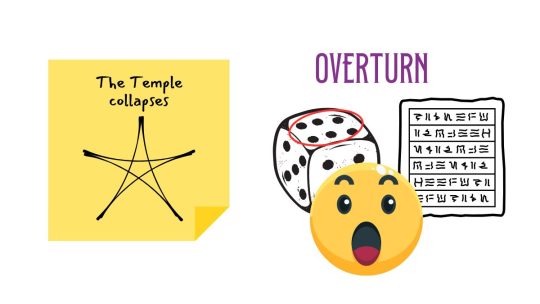
SIDE NOTE: I get it that using stars as a tally marker may not be the most intuitive graphical solution. I honestly chose it to meet the vibes of the game, and give it an air of mysticism, like it is more than just a counter. But I encourage you to use any form of tracking you prefer: tally marks, tokens, numbers, checking boxes and so on.
Flexible and modular
I hope that by now you can see this is more than a tool to count up to 5. If you follow me for a while, you know that I’ve toyed with the same idea in Derelict Delvers with Danger Clocks. In that game, they are restricted to represent monsters and obstacles. In Everspark, they can do all sorts of things.
You can use Sparks to track challenges, such as overcoming obstacles (including combat); the arrival of looming threats; the depletion of meaningful resources; contests between parties vying for the same goal; long-term projects like crafting, studying, or achieving a personal milestone; and conditions affecting characters, enemies, or environments.
Sparks can also track events like a lunar eclipse, the arrival of a king; the use of special power sources like mana or magical items with limited charges. They’re useful for tracking character advancement (including multiclassing), exploration (like a full journey or delving into a dungeon), or even montage scenes where you tackle complex challenges like making plans, setting camp, or preparing for a journey.

You can even create layered challenges to represent more complex or powerful enemies. Say you are fighting an enormous creature, and you want it to be a high-stakes and dramatic encounter. Instead of relying on “HP inflation” and just make, say, a 3-star Spark, you can represent different aspects of the challenge with separate Sparks, like a Spark representing an Arcane Shield that needs to be dealt with before harming it, and another one for its Spiked Tail that causes all sorts of trouble for melee attacks.

Instead of turning the combat in a boring meat grind, you have to approach the encounter as a puzzle. Different characters with unique skill sets can contribute, and the whole scene becomes more dynamic. You can even have environmental Sparks representing dangers or potential opportunities.
And the best thing is: you don’t need to prep that in advance. Crafting Sparks is part of the game. And I encourage you to do it as a collaborative process, if you’re playing in a group. We have a lot of fun brainstorming possible things we can add to a scene to make it even more memorable.
Spark-based scenarios
Picture this: you’re deciding who gets to be the next captain of the ship. It starts with a skill contest. It’s two candidates—you against them—and you are displaying skills to decide who’s going to be the captain. You have a resource Spark, which is the crew support. You can tap into it to gain leverage, but it can go either way—perhaps the crew support goes to your adversary, making it a double-edged resource.
You have to resolve this contest before the serpent god arrives (a threat) and, who knows, eats the loser of the contest. All the while, you’re dealing with the storm of the century (environment), which is battering the ship and tossing the crew around. On top of that, the ship is leaking (escalation)—because why not?
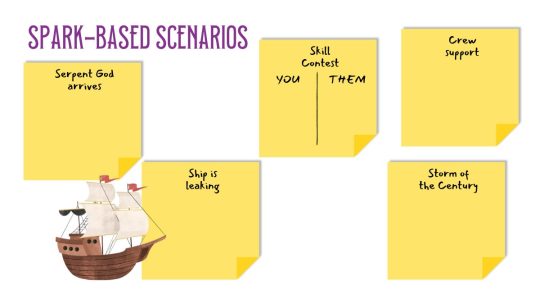
This can be a full session of chaos, crazy ideas, and unpredictable outcomes, with new Sparks being created as a result of complications and bad rolls. Others might be discarded as the situation evolves. It’s a wild, chaotic, and incredibly fun experience.
On top of that, you can bend the rules with “Spark tricks,” which are ways in which you twist and bend the rules of how to advance and resolve Sparks. These include locked rays (which can’t be hit), regenerating rays (that are erased), linked Sparks (where one Spark affects others), resistance (making two spark checks and keeping the worse result), and persistent Sparks (which remain active even after being resolved).
You get a sticky note! And you get a sticky note!
These are just a few ideas. It’s important to note that Sparks are modular, optional and disposable. They can be used for almost anything, but they shouldn’t be used for everything. You can handwave situations, roleplay them, or use just a few rolls to resolve them. But if you want more granularity, want to zoom into the action, or want to give more screen time to certain moments, Sparks can certainly help. And when a Spark is no longer relevant, you can simply discard it, even without resolving it.

It’s amazing all the things you can do with a simple piece of paper
My advice is that you introduce Sparks gradually into your gameplay—the book itself divides Sparks into Basic, Intermediate and Advanced. In my home game, we’re seventeen sessions in, and since all players are already comfortable with the mechanics, it is beautiful to see the proliferation of Sparks: characters are working on new skills, getting rid of curses, and trying to find lost relatives. The city has a creature about to arrive, a gang following them around, and more. All that tracked with Sparks.
Just think of nachos
When I was coming up with a checklist of the things you have to consider when creating a Spark, I had a pleasant surprise. See, you need to create the Name of whatever you’re tracking; decide how and when it Advances; when you need to make a Spark Check; what happens when you Hit a ray, what is a possible Overturn; and if there are any Special rules or conditions.
Hence, the NACHOS template was born.

Obviously, you don’t need to write every detail down for every Spark (or for most Sparks, really), but it is a good way to make sure everyone knows how the Spark behaves and to align expectations. If you want to play around with how a Spark works, just think of Nachos.
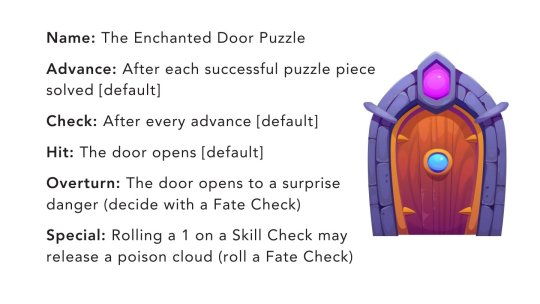

Hack it away
I’m super excited to get this in everyone’s hands and see what creative people can do with it by bending its rules and applications. I see it as a tool to inject a layer of tension, suspense and surprise to what could otherwise be just a tally count.
I’m working hard on editing Everspark at the moment (meanwhile, the campaign is on late pledge, so you can jump in if you want). It’s coming out nicely, I must say. The Sparks chapter has nearly 20 different suggested ways of using them, all with examples. And more nuance than I can fit on a post.
I’ve also published a video explaining this concept in even more detail:
youtube
Meanwhile, check out the campaign page and join us to keep the Everspark alive! And I’d sincerely appreciate it if you shared this around with people that might like it.
115 notes
·
View notes
Text
this is it right there
Reblog to Save a Life
I have talked about it before, but independant artists, and by extension independant TTRPG designers like myself and my team, live and die by their social media presence. We can't afford a lot of advertising, if any, and so we rely not only on word-of-mouth advertisement, but also just the good will of our audience. Like another designer @cavegirlpoems put it, we're basically busking, putting our art out for everyone and hoping for voluntary donations, donations which I writing this am reliant on as a disabled designer who can't work a normal job.
If you can't pay, you can still have it for free, and something that can be just as helpful is reblogging the posts of artists like myself. I'll demonstrate with a screenshot from our itch.io page for the open beta for Eureka: Investigative Urban Fantasy.

(and on these days, it was only about 6 or 7 people who did the reblogging.)
As you can see, reblogs mean more people see our game, which means more downloads (and sometimes even payments), downloads mean more people play our game and more people see our game in the itch.io algorithm, which means more views, which means more downloads, which means more and so on and so on. But, it all starts with you reblogging our posts, and without that, we're stagnate. It doesn't matter if you have 1,000 followers or 10, your reblog means that our posts reach corners of tumblr that wouldn't have seen it otherwise.
Myself and others are reliant on a 2-second reblog to be able to support ourselves as artists, you and your 10 followers are where it starts.
1K notes
·
View notes
Text
A game that says 'Yes' more
Alright folks, here it is:
🌟Everspark🌟
This is my answer to the question:
'What if we stripped everything off of heroic fantasy TTPRGS and kept only the vibes?'
The story behind this game starts 30 years ago…

I remember my first RPG experience. The art, the setting, the idea of being a hero in a fantasy world that we discovered together—it all seemed magical.
But very soon the cracks started to show.
A disconnect between the promise and the experience delivered by the game.
It took me more than 30 published games to give this one a go, mostly due to self-consciousness ("Really? Another fantasy heartbreaker?")
But I had to do it.
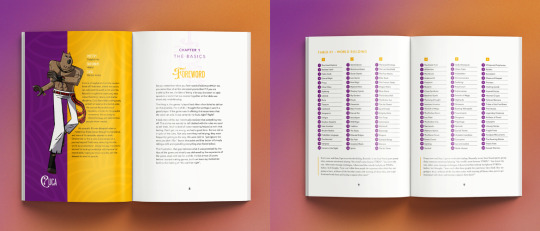
I had to know—what if we could actually live the promise that those book covers sold?
What if we could offer new players the experience they think they will have with that one game, without the frustration of a ruleset that says 'no' all the time?
That’s how Everspark was born.
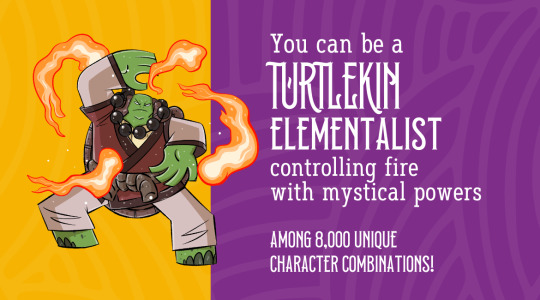
I want to provide those carefree, belly-laugh-filled, let’s-play-pretend moments of rolling dice, casting imaginary spells, and coming up with all sorts of shenanigans.
A great choice if you want to introduce the hobby to newcomers, or play with your kids (or parents!)
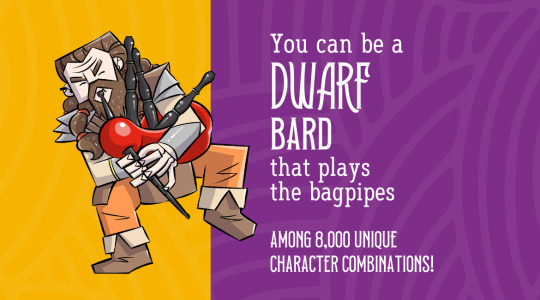
I want to reignite that original spark that first attracted us to these kinds of games and never left us—the Everspark, if you will.
You get to tell epic tales, celebrate nat-20s, lament nat-1s, and spend some quality time daydreaming about dragons.
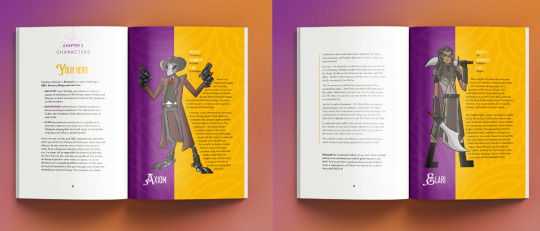
The system is super simple: You roll a d20 and 'eyeball' the result to see if you get a critical, regular or mixed success (or failure).
Besides that, there's only a quirky little mechanic involving drawing stars on sticky notes that covers everything else you need.

You can play solo or in a group, with or without a GM.
There are 8,000 possible character combinations, and you can make one in 20 seconds.
The game is very welcoming to foreign material, like settings, adventures, monsters, weapons, spells, and more!
All the art is by the amazing Ray Olli (and during the campaign, you can have your own custom character illustrated by him!)
Look at that:

And, if nothing else has convinced you so far, you can play as a Capoeira Capybara:
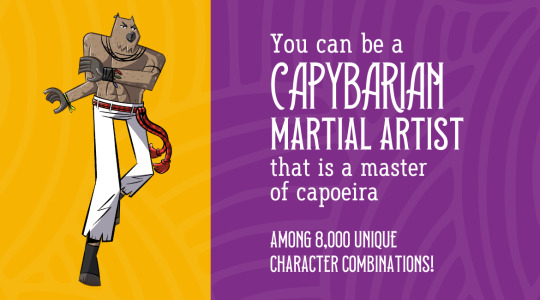
Everspark is funding now, and I'd appreciate your support and enthusiasm!
Please share it with anyone that wants to try a rules-light, vibes-full heroic fantasy tabletop game!
Make an indie designer happy today! 😊
59 notes
·
View notes
Text
A one-page Player Character Emulator
Second release in a week, somebody STOP ME
'Triple-O' is my take on a one-page Player Character Emulator
⭕ Run published adventured modules as a solo GM! ⭕ Test-run your world-building, adventure, or prep ⭕ Emulate allies or hirelings

Spread the word! 😊💗
274 notes
·
View notes
Text
Metagaming Is Good, Actually, You Just Suck At Playing Pretend
OK so metagaming is a term with an incredibly nebulous definition, but the way it gets thrown around - particularly in That Fandom - is just ridiculous. You are, in fact, playing a game. For fun. You should make your in-game decisions based on what will be most enjoyable for you, and the other participants in this game, and to do that well, the nature of the game is a consideration.
Some, non-exhaustive, examples of positive metagaming: -Deliberately taking plot-hooks even when you don't have a good IC reason to. -Deliberately grouping up with the other PCs even if they're basically strangers. -Making genre-appropriate decisions for the type of game you're in (being overly curious in Call of Cthulhu or petty and melodramatic in Monsterhearts). -Making tactically optimal choices in challenge-based games (such as osr dungeon-exploration, or 4e combat). -Not taking actions that will be unwantedly upsetting for other players ooc (such as not using arson as a weapon if a player has trauma relating to a house-fire).
'being in character' is not a suicide-pact compelling you to make bad decisions because 'it's what my character would do', and indeed 'it's what my character would do' is shorthand for a particular type of shit player for a good reason! If you fuck things up by making stupid ic decisions, or unfun ooc decisions, to avoid 'metagaming', you're a shit player.
If 'how would I know that' comes up, you can just make something up to explain it. RPGs are games about making things up. Add an incident to your backstory, maybe, and get some free character development out of it.
Anyway, yeah, despite what some people will tell you, metagaming is a positive behaviour so long as you're not deliberately using it to enable behaviours that would be toxic even without metagaming.
2K notes
·
View notes
Text
Your definitely-not-stolen spaceship
Alright, here's my submission to the One-Page RPG Jam:
Hunk o' Junk
Play as a duo of space scoundrels trying to recover "their" impounded ship.
But here's the catch: the agent asked each of you to sketch half of the ship to see if your descriptions match…
Wait, what?
That's right.

You've managed to “acquire” a shabby spaceship, but before you could even take it for a joyride, it got impounded!
Now, your beloved vessel is locked away in a government impound lot, guarded by a no-nonsense agent who’s not easily fooled.

Taking turns, you're each describing and drawing half of the ship without peeking at your partner's masterpiece, adding more details as you go.
There's a bunch of tables with ways to alter the shape of the spaceship.
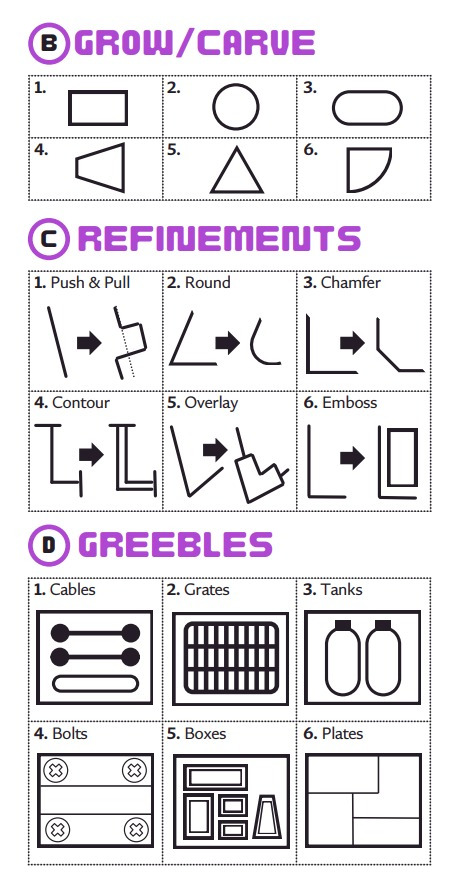
As you invent outrageous tales about these parts, you must slip in some clues to let your partner know where to add the same element in their mirrored half of the drawing.
And don't make it obvious to the agent that you're trying to coordinate your stories!

After a handful of rounds, you put your sketches together for the final review.
If your drawings line up when you're done, you'll fly away in your beautiful bucket of bolts.
If not… well, it's time to get creative with Plan B!
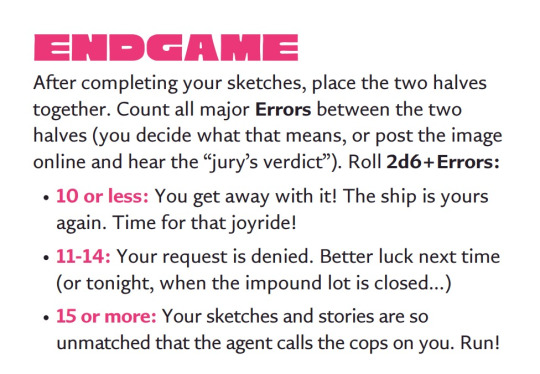
Hunk o' Junk is a light-hearted two-player story-drawing game (with solo and 3-player variants) that I believe will get a laugh out of you!
Especially when you put your two halves of the drawing together XD

If that sounds interesting to you, check it out here!
It's on s@le until the end of the jam!
118 notes
·
View notes
Text
They’ve released not just digitized works of art, but also a great many art history texts and art books in general. Just this week, they announced an expansion of access to their digital archive, in that they’ve made nearly 88,000 images free to download on their Open Content database under Creative Commons Zero (CC0). That means “you can copy, modify, distribute and perform the work, even for commercial purposes, all without asking permission.”
88,000 new free images just dropped, to use however you like.
23K notes
·
View notes